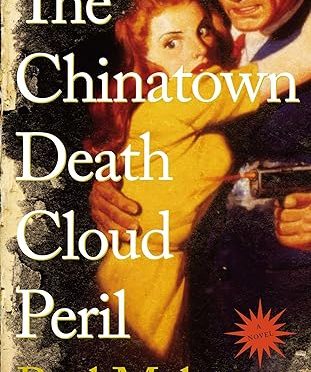The Chinatown Death Cloud Peril
by Paul Malmont
A Review by Machine Trooper
This is both a retro-pulp novel and a love letter to the legendary pulp authors. In a book like this, you just have to start off with the cast of…
CHARACTERS:
This is fiction, built around people who made a living writing fiction, but were quite real themselves. Some pulp authors are merely discussed (Robert E. Howard; Edgar Rice Burroughs; etc.) but a handful are protagonists in the story, including Walter Gibson; Lester Dent; H.P. Lovecraft; L. Ron Hubbard; Louis L’Amour and Robert Heinlein.
I presume these men were all dead before the author conceived this project, so he had to piece their personalities together via extensive research. Some traits are easy to infer: with the exception of L’Amour, these men were not men of action (though some had traveled internationally and held a variety of jobs) but they admired such men. They were all well read, introspective, and, of course, storytellers.
Malmont was careful not to portray their personalities as one type or another too explicitly, mostly content to fill in the background of the characters piecemeal so the reader can complete the profile. This was a wise choice. most of the time, with limited details about even most famous people, posthumously, it would be easy to get it wrong.

I worried about this while preparing to write my magnum opus. The safest way to go would have been to replace the 1969 Minnesota Vikings with a made-up team full of made-up players. I had a pretty good handle on Bud Grant, having seen so many interviews of him; having read so much about him by those who knew him, and his own autobiography. But the legendary players on that roster were mostly mysterious, with the exception of their feats on the field and some anecdotes about them off of it.
I went with first-person narration from the hero and limited him to typical jock interactions with the iconic players. The most fully-rendered Vikings were Grant, and a fictional backup quarterback I invented to replace Bob Lee, with whom the hero spends the most time off the field.
Malmont’s path was riskier, but worked well enough. Nobody jumped off the page, but I did learn details about the legendary pulp authors I didn’t know before:
Gibson’s obsession with magic and basically being a magician groupie…and having relations with the wife of a lesser one. His abandonment of his own wife and child to pursue a living writing in the Big Apple (making it an easy choice to portray Gibson as guilt-ridden). Also…was he a drug addict?
Dent’s grudge against Gibson for having one of his stories quashed in the early days. His close relationship with his own wife, despite her inability to conceive. Their shared love for adventure.
Hubbard’s ambition and networking among the pulperatti in New York.
Heinlein’s sketchy, perhaps shady, personal history before he began using his own name and trying out the writing game for himself. He comes off as kind of an S.O.B.–I will probably chase that down myself one day if I have time.
PLOT:
Speaking of shady: an amoral U.S. Army officer has used his office to insert himself into the internal politics of China. He has worked out a deal to supply the Chinese with a deadly WWI vintage chemical agent (the eponymous “death cloud”) to be used on the Japanese invaders. Some unfortunate men have already been exposed to the gas, and it turned them into mutant zombies…or something similar.
Our pulp authors/heroes are opposed to the plan to use it on Japan (once they discover it) because the inevitable collateral damage would be extensive. I have no doubt Malmont intended this to be an ironic objective. In the setting of the novel, in a few years the allies will be slaughtering civilians by the trainload in cities like Dresden, Hamburg, Hiroshima and Nagasaki.
Each of the pulp authors (and Dent’s wife) will meaningfully contribute to the effort to save the day.
CONCLUSION:
Malmont was careful to spread the plot burden around evenly amongst Gibson, Dent, and Hubbard–and to a lesser extent, upon L’Amour and Heinlein. While this avoids upstaging any of them, perhaps it also prevents the reader from investing in or relating to any one of them as we would with, say, the Shadow or Doc Savage.
Also, the resolution of the plot was a little drawn out, since each author/character needed their own personal loose ends tied up. I suspect this will confine The Chinatown Death Cloud Peril as a sort of novelty, well-received by fans of the pulps. But it might never break out as a popular novel, for readers who are not “in” on the joke
Let me know what you think in the comments.
And if you like superhero comics, check out the chapters I’m sharing from my new graphic novel, for free!

